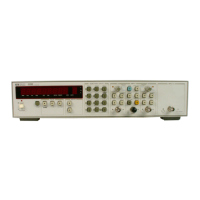Be careful to place the scope probe on one pin at a time. If two pins are
accidently shorted by the scope probe, you may not observe the correct
signals. You will have to repeat the steps a through d of the Setup proce-
dure.
Test
a.
Use an oscilloscope to observe the signals described below. All are
'ITL levels
U29
Measurement MCU
Pin
1
-
4 MHz sawtooth waveform
Pin 2
-
4
MHz sine wave with no dc offset voltage
Pin 3
-
LOW
Pin
4
and Pin 5
-
Line Toggles
Pin
6
-
HIGH
Pin
7
to Pin 15
-
Line Toggles
Pin 16
-
HIGH
Pin 17 and Pin 18
-
Line Toggles
Pin
19
-
HIGH
Pin
20
-
LOW
Pin 21
-
LOW
Pin 22 to Pin
37
-
Line Toggles
Pin
38
-
HIGH
Pin 39
-
HIGH
Pin
40
-
HIGH
b. If any signals measured are incorrect, replace the Measurement MCU
(U29).
8-363. If there is still trouble in the Measurement Block, check to see
if
a RATIO
A/B
measurement can be
performed by connecting the
10
MHz Time Base output from the rear panel to the Channel A Input and setting
the COMMON
A
mode. This ratio measurement uses only the
E
and T registers in the Multiple-Register
Counter (MRC) and not the Interpolators. The measurement should be
1.000 000
&
.000
001.
8-364. If the Counter does not perform the RATIO measurement correctly:
a.
Verify that the 10 MHz Time Base signal is getting to the MRC at U20 pin 21. This signal should
have a
minimum amplitude of
600
millivolts peak-to-peak.
b.
Check the Channel A and B inputs to the MRC
U20 at pins
28
and
30.
There should be a 10 MHz
signal with an amplitude of
800
millivolts on a dc level of
+
2.4 to
+
3 volts at both pins. Also check
to see that the control lines from the Measurement MCU at pins
1,3,
and
40
of U20 are changing
state at
'ITL
levels.
c.
If all of these signals are observed, yet a RATIO
A/B
measurement cannot be performed, replace
MRC
U20.
HP
5334B
-
Service
Manual
8-52

